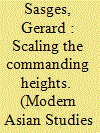|
|
|
Sort Order |
|
|
|
Items / Page
|
|
|
|
|
|
|
| Srl | Item |
| 1 |
ID:
156137


|
|
|
|
|
| Summary/Abstract |
This paper examines issues of techniques and factor analysis in research in general and in military history research in particular, which determine the functioning conditions for the phenomenon or process under examination.
|
|
|
|
|
|
|
|
|
|
|
|
|
|
|
|
| 2 |
ID:
140940


|
|
|
|
|
| Summary/Abstract |
By the late 1800s the colonial state's increasing capacity to regulate, finance, and tax had begun to open up new opportunities for locally based French enterprises in Indochina. Chinese syndicates that had previously dominated the economy found themselves deprived of existing revenue streams and denied access to new ones. The result was an ‘Indochinese moment’ when a handful of colonial conglomerates used profits from state contracts, monopolies, and subsidies as a base for growth and diversification after 1900. Yet scaling the commanding heights of the economy was not easy, and was only achieved thanks to sustained and powerful state intervention. Moreover, one of the effects of the economic crisis after 1928 was the end of this Indochinese moment and a shift in initiative to a new partnership that linked an increasingly technocratic state with the financiers and experts of the Bank of Indochina. This article investigates this complex interaction of state power, technology, and capital flows with local Chinese, French, and indigenous Indochinese actors, using one particular conglomerate, the Fontaine group, as a case study to shed light on the mechanisms that linked an interventionist state to capitalist enterprise and ultimately to the remaking of the Indochinese economy.
|
|
|
|
|
|
|
|
|
|
|
|
|
|
|
|
| 3 |
ID:
136042


|
|
|
|
|
| Summary/Abstract |
Deformation study of projectile immediately after firing is essential for its successful impact. A projectile that undergoes more than the tolerated amount of deformation in the barrel may not produce the requisite results. The study of projectile deformation before its impact requires it to be imaged in flight and perform some computation on the acquired image. Often the deformation tolerance is of the order of tens of micrometer and the acquired image cannot produce image with such accuracy because of photographic limitations. Therefore, it demands sub-pixel manipulation of the captured projectile image. In this work the diameter of a projectile is estimated from its image which became blur because of slow shutter speed. First the blurred image is restored and then various interpolation methods are used for sub-pixel measurement. Two adaptive geometrical texture based interpolation schemes are also proposed in this research. The proposed methods produce very good results as compared to the existing methods.
|
|
|
|
|
|
|
|
|
|
|
|
|
|
|
|
| 4 |
ID:
190023


|
|
|
|
|
| Summary/Abstract |
Previously rare events, mass protest movements have become popular vehicles for those seeking political, economic, and social change. How do we evaluate movement success? Most studies addressing movement outcomes are grounded in the goal attainment approach, where movement success is dependent upon fulfilling one’s stated demands. The models derived from this approach heavily rely on visibility and transparency in the policymaking process. These offer limited analytical utility for scholars studying movements in authoritarian states, where policymaking is shrouded and media is state-controlled. Evaluating movements solely on their fulfillment of mission goals is highly problematic, as movements produce more outcomes than their intended goals. Movements also produce unintended benefits: concessions unrelated to the movement’s mission. These include negative consequences, or societal costs. Since movements produce both positive and negative unintended outcomes, any evaluation of a movement should also incorporate the costs associated with new gains. I argue a cost–benefit approach improves scholarly conceptualization and measurement of protest success. I conceptualize protest success as multidimensional and comprised of protest gains and societal costs. I develop a 21-point scale of protest success using Mokken Scale Analysis. AISP diagnostics indicate gains and costs comprise separate subscales, which are collapsed to produce total sum scores. I score 34 nonviolent movements in authoritarian states between 2002 and 2013 on an additive scale. Protests in authoritarian settings attain considerable accomplishments; however, those gains come with significant cost. Most total success scores are negative, indicating considerable backlash is common during and immediately after the demobilization of movements in authoritarian states. Success scores improve upon the canonical binary measure by: (1) offering improved discrimination between movements, (2) identifying cases of regime ‘ignoring’, and (3) pinpointing misclassified cases. By incorporating negative consequences into our evaluations, we advance our understanding why movements deemed successful by scholars are disappointments to their home publics.
|
|
|
|
|
|
|
|
|
|
|
|
|
|
|
|
|
|
|
|
|